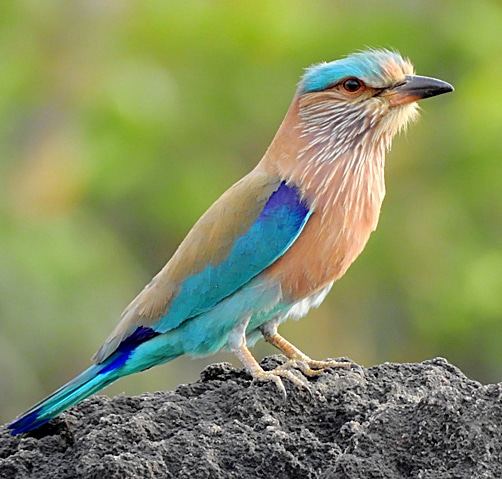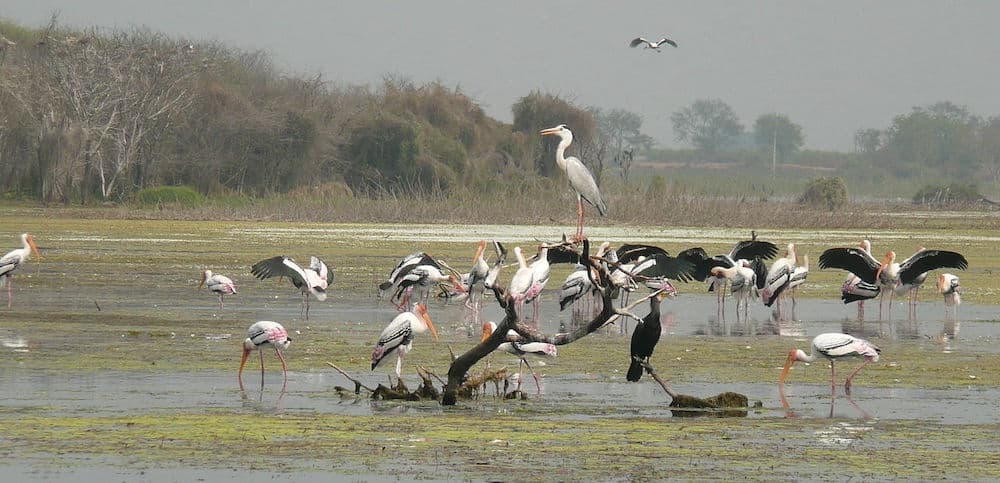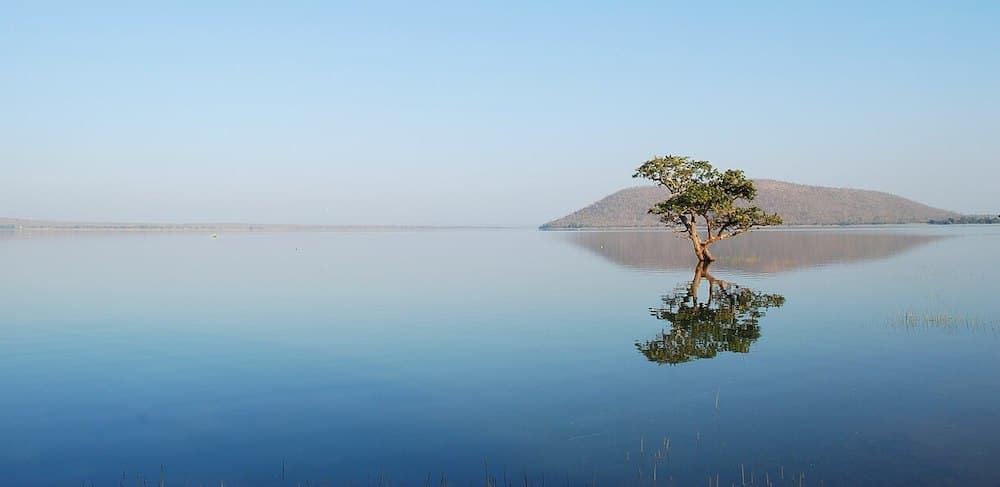Telangana

Telangana is a landlocked state in India situated in the southern-central part of the Indian peninsula on the high Deccan Plateau. It is the eleventh largest state at just under 115,000 km2 and the twelfth most populated state in India with about 40 million people. On 2 June 2014, the area was separated from the northwestern part of Andhra Pradesh, with Hyderabad, its largest city with a population of over 11 million inhabitants as its capital. Telugu, one of the classical languages of India, is the most widely spoken and the primary official language of the state.
The economy of Telangana is the ninth-largest in India, and has emerged as a major focal point for IT software companies, industry and the services sector. The state is also the main administrative centre of many Indian defence aerospace and research labs including Bharat Dynamics Limited, Defence Metallurgical Research Laboratory, Defence Research and Development Organisation and Defence Research and Development Laboratory.
The region is drained by two major rivers, with about 79% of the Godavari River catchment area and about 69% of the Krishna River catchment area, but most of the land is arid. Telangana is also drained by several minor rivers such as the Bhima, the Maner, the Manjira, the Musi, and the Tungabhadra.

Manjira Wildlife Sanctuary – ©Ravinder Thakur, CC BY-SA 3.0 via Wikimedia Commons
Telangana is a semi-arid area and has a predominantly hot and dry climate. Summers start in March, and peak in mid-April with average high temperatures in the 37–38 °C range. The monsoon arrives in June and lasts until Late-September with about 30 inches of precipitation. A dry, mild winter starts in late November and lasts until early February with little humidity and average temperatures in the 22–23 °C range. The annual rainfall is between 35 and 59 inches in northern Telangana and 28 to 35 inches in southern Telangana, from the southwest monsoons. Telangana contains various soil types, some of which are red sandy loams (Chalaka), Red loamy sands (Dubba), lateritic soils, salt-affected soils, alluvial soils, shallow to medium black soils and very deep black cotton soils. These soil types allow the planting of a variety of fruits and vegetable crops such as mangoes, oranges, coconut, sugarcane, paddy, banana and flower crops.
Birding Telangana
The Central Deccan Plateau dry deciduous forests ecoregion covers much of the state, including Hyderabad. The characteristic vegetation is woodlands. However, 80% of the original forest cover has been cleared for agriculture, timber harvesting, or cattle grazing, but large blocks of forest can be found in Nagarjunsagar-Srisailam Tiger Reserve (the largest tiger reserve in India) and elsewhere. The more humid Eastern Highlands moist deciduous forests cover the Eastern Ghats in the eastern part of the state.

Pakhal Lake – ©Alosh Bennett, CC BY 2.0 via Wikimedia Commons
Telangana has three National Parks: Kasu Brahmananda Reddy National Park in Hyderabad district, and Mahavir Harina Vanasthali National Park and Mrugavani National Park in Ranga Reddy district. Wildlife Sanctuaries in Telangana include Eturunagaram Wildlife Sanctuary and Pakhal Wildlife Sanctuary in Warangal District, Kawal Tiger Reserve and Pranahita Wildlife Sanctuary in Adilabad district, Kinnerasani Wildlife Sanctuary in Khammam district, Manjira Wildlife Sanctuary in Medak district, Nagarjunsagar-Srisailam Tiger Reserve in Nalgonda and Mahbubnagar districts, Pocharam Wildlife Sanctuary in Medak and Nizamabad districts, Shivaram Wildlife Sanctuary in Karimnagar district. Sacred groves are small areas of forest preserved by local people. Sacred groves provide sanctuary to the local flora and fauna. Some are included within other protected areas, like Kadalivanam in Nagarjunsagar–Srisailam Tiger Reserve, but most stand alone. There are 65 sacred groves in Telangana—two in Adilabad district, thirteen in Hyderabad district, four in Karimnagar district, four in Khammam district, nine in Mahbubnagar district, four in Medak district, nine in Nalgonda district, ten in Ranga Reddy district, and three in Warangal district.
The protected land and attitude of people is good news for wildlife in general and birds are no exception with over 500 birds having been recorded in the state.
-
Adilabad District
Satellite ViewNorthern most district of the state known for lush green forests. Kuntala waterfalls: 22km from Adilabad town. Picturesque location with lush green jungles around. Pochera waterfalls: 50km from Adilabad town. River Godavari`s rapids meandering through the jungle and flowing over the rocky slopes is a breathtaking scene. Sivaram Wildlife Sanctuary: 50km from Mancherial, Adilabad. Riverine forest known for large ungulates and an occasional Tiger. Kawal Wildlife Sanctuary: 50km from Mancherial, Adilabad. A large wilderness area with dry deciduous forest. Noted for large ungulates and bird diversity. Pranahita Wildlife Sanctuary: 35km from Mancherial, Adilabad. Surrounding Pranahita, one of the major tributaries of Godavari, is known for rock fossils. Diverse mammals and birds can be sighted. -
Anantagiri Reserve Forest - Ranga Reddy
InformationSatellite ViewRanga Reddy district, approximately 70km from Hyderabad. A hilly range of small, dense jungle with wooded valleys. Known for the resident and breeding Crested Hawk-eagle, Spizaetus cirrhatus and Crested Serpent eagle Spilornis cheela. -
Durgam Cheruvu (Secret Lake)
InformationSatellite ViewJubilee Hills, Hyderabad. A natural wonder on whose secrecy the glory of the bygone Golconda kingdom depended heavily upon. A moderate sized lake surrounded by hillocks on all the sides can be a perfect getaway in monsoon and winter. Huge boulders provide ample vintage points. The regulars being Indian River Tern Sterna aurantia. -
Hyderabad Central University campus
ArticleSatellite ViewThere are approximately 120 varieties of birds on the campus. It's one among the few urban forest areas which has animals in natural habitat, like Spotted Deers, Wild Boars, Star Tortoises etc. and Snakes -Indian Rock Python, Vipers, Cobras, Boas, Kraits etc. -
Indira Park, Sanjeevaiah Park & Hussain Sagar lake - Hyderabad
InformationSatellite ViewHyderabad, in the heart of the city, is known for garden birds. Hussain Sagar lake harbours a large number of resident and migrant waterfowl, while it's fringes are known for migrant Wagtail species. -
Karimnagar district
Satellite ViewApproximately 160km from Hyderabad. Sivaram Wildlife Sanctuary: 80km from Karimnagar town, is contiguous with it's counterpart in Adilabad district. -
Kasu Brahmananda Reddy National Park - Hyderabad
InformationSatellite ViewHyderabad in the heart of the city is a good birding location for the local dry areas and scrubland species. -
Lakes of Hyderabad
The numerous lakes of Hyderabad host a wide variety of winter migrants. These are usually named after their location like Saroornagar,Fox Sagar, Mansoorabad, Safilguda etc. Sadly, all of them are facing major crises in the form of encroachment and pollution by sewage. -
Mahavir Deer Park – Hyderabad
InformationSatellite ViewHyderabad, 17km east of the Hyderabad city centre is sure location to sight the Stone Curlew Burhinus oedicnemus apart from large herds of Blackbuck Antilope cervicapra and Spotted Deer. -
Manjeera Reservoir (Manjira Wildlife Sanctuary) - Medak
InformationSatellite ViewMedak district is approximately 70km from Hyderabad. Secluded islands in the freshwater reservoir shelter a large breeding colony of Painted Storks, Mycteria leucocephala and Indian Darter Anhinga melanogaster. -
Medak District
Satellite View90km from Hyderabad. Medak lake: On the outskirts of the town,gives a magnificent view of the famous 'Medak Cathedral', one of the finest examples of Gothic architecture in India. Lake hosts regular winter migrants and the breeding residents. Pocharam Wildlife Sanctuary: 15km from Medak town. The 9.12sqkm man made lake is surrounded by jungle providing the birders with sightings of both the waterfowl and the woodland birds. -
Narsapur Reserve Forest - Medak
Medak district, approximately 60km from Hyderabad. This is a dense patch of forest known for woodland species, notable for Woodpeckers. -
Nehru Zoological Gardens - Hyderabad
InformationSatellite ViewHyderabad - One of the best zoos in India this has a large wild area and a large lake attracting many waterfowl. -
Osmania University Campus: Hyderabad
ArticleSatellite ViewExternal lungs of the city, a densely wooded and serene area. There can always be a surprise delight on any early morning birding. -
Satyam Technology Centre
Satellite View20km northwest of Hyderabad in Bahadurpally village. The R&D centre of the software major is a wonderful birding area. Largely untouched land resulted in wild growth much to the delight of any birder. Hillocks in the campus add a magical touch to the already wonderful birding experience. -
Shameerpet Lake
InformationSatellite View20km northeast of Secunderabad on Hyderabad Karimnagar highway. Large fresh water lake with wild rocky country surrounding it is a bliss for any birder with a keen interest in Larks. The claim to the fame being Syke`s Crested Lark Galerida deva. The dry scrubland hosts numerous other species of Larks. -
Warangal District
Satellite ViewApproximately 140km from Hyderabad. Ramappa lake: 70km from Warangal city. This lake adjoins an ancient temple built in 13th century by one of the most famous and powerful kings of Telugu speaking people. The intricate architecture and rich history complements a wonderful birding experience. Pakhal Lake & Wildlife Sanctuary: 50km from Warangal city. A veritable haven for the winter migrants. Few of the rare migrant waders can be sighted here.
-
Number of bird species: 502
(As at July 2024)State Bird: Indian Roller Coracias benghalensis
- Breeding Endemic: Kashmir Flycatcher Ficedula subrubra
-
Avibase
PDFChecklistThis checklist includes all bird species found in Telangana , based on the best information available at this time. It is based on a wide variety of sources that I collated over many years. I am pleased to offer these checklists as a service to birdwatchers. If you find any error, please do not hesitate to report them. -
BUBO
ChecklistThis checklist includes all species that have been reported in Telangana in eBird, but updated to IOC taxonomy, together with the likelihood of seeing each species for each month of the year. -
Wikipedia
Annotated ListThe state of Telangana, India, has 497 bird species within its boundaries. The official state bird of Telangana is the pala pitta,[1] also known as the Indian roller, Coracias benghalensis. -
eBird
PDF ChecklistThis checklist is generated with data from eBird (ebird.org), a global database of bird sightings from birders like you. If you enjoy this checklist, please consider contributing your sightings to eBird. It is 100% free to take part, and your observations will help support birders, researchers, and conservationists worldwide.
-
Deccan Birders (Formerly BSAP)
WebsiteDeccan Birders is a non-governmental organization founded in 1980 (as Birdwatchers Society of Andhra Pradesh and renamed as Deccan Birders in 2018) by a few enthusiasts of Telangana/Andhra Pradesh with the primary objective of spreading the message of bird conservation. Deccan Birders is registered under the Public societies Registration Act – I of 1350F. -
Hyderabad Birding Pals
Facebook PageThis Facebook Group encourages scientific observation & documentation of birds of India in natural wild habitat.
-
NP Mrugavani National Park
InformationSatelite ViewMrugavani National Park is a national park located in Hyderabad, Telangana State, India. It is situated at Chilkur in Moinabad mandal, 20 km from MGBS and covers an area of 3.6 square kilometres (1.4 sq mi) or 1211 acres. It is home to a 600 different types of plant life. The Park is home to around 350 spotted deer. The animals include: indian hare, forest cat, civet, Indian rat snake, Russell's viper, chital and the flower pecker. -
NP Kasu Brahmananda Reddy National Park
InformationSatelite ViewThe park has over 600 species of plant life, 140 species of birds and 30 different varieties of butterflies and reptiles. Some of the animals making their home in the park include: pangolin, small Indian civet, peacock, jungle cat and porcupines. There are few water bodies present in the park providing the needed moisture for the plants and quenching the thirst of birds and small animals. -
NP Mahavir Harina Vanasthali National Park
InformationSatelite ViewAnimals living in this national park include a few hundred blackbucks (the state animal of Andhra Pradesh), chitals,porcupines, water monitors, short-toed eagles, Indian pond herons, egrets, kingfishers, cormorants and several other bird species. -
TR Nagarjunsagar-Srisailam Tiger Reserve
InformationSatelite ViewNagarjunsagar-Srisailam Tiger Reserve is the largest tiger reserve in India. The reserve spreads over five districts, Nandyal District, Prakasam District, Palnadu District, Nalgonda District and Mahabub Nagar district. The total area of the tiger reserve is 3,728 km2 (1,439 sq mi).[1] The core area of this reserve is 1,200 km2 (460 sq mi). The reservoirs and temples of Srisailam are major attraction for many tourists and pilgrims.[2] It is the largest tiger reserve forest in India and is located inside Nallamala forest area. -
WS Eturnagaram Wildlife Sanctuary
InformationSatelite ViewA perennial water source called "Dayyam Vagu", divides the sanctuary into almost two halves. It is home to Tiger, Leopard, Wolf, Dholes, Golden jackals, Sloth bear, Chousingha, Blackbuck, Nilgai, Sambar, Spotted deer, Chinkara, and Indian giant squirrels. Also found are many kinds of birds, and reptiles such as Mugger crocodile, Python, Cobra, and Krait. -
WS Kawal Wildlife Sanctuary
InformationSatelite ViewThe reserve is the oldest sanctuary in the northern Telangana region of the state. It is well known for its abundant flora and fauna. This sanctuary is catchment for the rivers Godavari and Kadam, which flow towards the south of the sanctuary. -
WS Kinnerasani Wildlife Sanctuary
InformationSatelite ViewThis wildlife sanctuary has a forest mixed with dense scrub and meadows. It comes under the Eastern Highlands moist deciduous forests. Rich in mammal species in particular. -
WS Manjira Wildlife Sanctuary
InformationSatelite ViewOriginally a crocodile sanctuary developed to protect the vulnerable species mugger crocodile, today it is home to more than 70 species of birds. The reservoir, located in the sanctuary, provides drinking water to Hyderabad and Secundarabad. -
WS Pocharam Wildlife Sanctuary
InformationSatelite View...was a former hunting ground of the Nizam that was declared a wildlife sanctuary in the early 20th century. It is named after the Pocharam lake, formed from the bunding of the Allair from 1916-1922. The sanctuary has an ecotourism center for visitors. It is home to many species of birds and mammals. -
WS Pranahita Wildlife Sanctuary
InformationSatelite ViewThis sanctuary is on the bank of Pranahita River, 35 km away from Mancherial town. It is famous for Blackbuck and over 20 species of reptiles, over 50 species of birds, over 40 species of mammals. -
WS Shivaram Wildlife Sanctuary
InformationSatelite View...home to marsh crocodiles from the river Godavari. It also harbours Indian leopards, sloth bears, nilgai, blackbucks, chitals, pythons, and langurs. The undulating natural terrain adds to the beauty of the sanctuary... -
WS Toggle the table of contents Pakhal Wildlife Sanctuary
InformationSatelite ViewEncompassing a vast expanse of 839 square kilometres, the sanctuary spans across the area, and is home to a variety of wildlife, including tigers, leopards, sloth bears, chital, nilgai, and four-horned antelope.
-
Guides for Telangana - Munna
GuideBirding locations covers Andhra Pradesh, Nallamala Tiger Reserve, Maredumilli, Telangana, Pakhal Wildlife Sanctuary, Kinnerasani Wildlife Sanctuary, Anantagiri Hills
-
2017 [05 May] - Ajinkya Supekar - Telangana
ReportTelangana. It is on the fringes of Papikonda National Park in Andhra Pradesh. The forest is semi evergreen- deciduous, known for bamboo and rosewood. Parnasala is a temple near Bhadrachalam with Godavari river flowing close to it. We were four of us: Naresh Vadrevu, Phani Krishna Raavi, Gopalkrishna Iyer and Me. -
2015 [12 December] - S S Cheema - Hyderabad
Report...The birding did not disappoint at all. I saw a total of 33 species and the notables included India Thick-knee, White-bellied Drongo (my first good shot of the bird), Black-headed Cuckooshrike, Indian Cormorant (Indian Shag) and the Great Cormorants....
-
Best Bird Watching Trails in Hyderabad
WebpageExplore the most popular bird watching trails near Hyderabad with hand-curated trail maps and driving directions as well as detailed reviews and photos from hikers, campers and nature lovers like you -
Best Bird Watching Trails in Telangana
WebpageExplore the most popular bird watching trails in Telangana with hand-curated trail maps and driving directions as well as detailed reviews and photos from hikers, campers and nature lovers like you. -
Bird watching destination Telangana
WebpageAmeenpur Lake – With the help of NGOs and cleaning of the area have helped to maintain the beauty and the credibility of this place and now it supports more than 200 species of birds, namely, Flamingos, Painted Storks, Asian Openbills, kestrels, kingfishers, bee-eaters, Hoopoes, and pelicans. -
Birdwalk At Damagundam Forest, Telangana
WebpageHyderabad Birding Pals, a birding group, is conducting a full day assisted birdwalk at Damagundam Reserve Forest in Vikarabad in Telangana. Join in for a day full of birding with experienced birders! -
Top 8 Places To Go Birdwatching—Hyderabad
WebpageA list of birding hotspots in and around the historic city of Hyderabad
